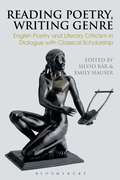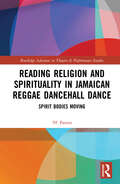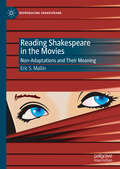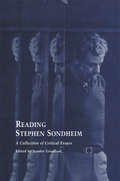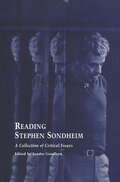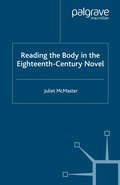- Table View
- List View
Reading Olympe de Gouges
by C. ShermanOlympe de Gouges has been called illiterate, immoral, and insane while being mentioned solely for her Declaration of the Rights of Woman and [the female] Citizen. This book uncovers her radical views of the self, the family, and the state and accounts for her vision of increasing female agency and decreasing the entitlements of aristocratic males.
Reading Photographs: An Introduction to the Theory and Meaning of Images (Basics Creative Photography)
by Richard SalkeldReading Photographs is a clear and inspiring introduction to theories of representation and visual analysis and how they can be applied to photography. Introducing the development of photography and different approaches to reading images, the book looks at elements such as identity, gaze, psychoanalysis, voyeurism and aesthetics.Striking visual examples are used to illustrate the text and engaging case studies delve deeper into issues raised within each chapter, with brief activity points to allow the reader to apply relevant theories to their own practice.
Reading Photographs: An Introduction to the Theory and Meaning of Images (Basics Creative Photography)
by Richard SalkeldReading Photographs is a clear and inspiring introduction to theories of representation and visual analysis and how they can be applied to photography. Introducing the development of photography and different approaches to reading images, the book looks at elements such as identity, gaze, psychoanalysis, voyeurism and aesthetics.Striking visual examples are used to illustrate the text and engaging case studies delve deeper into issues raised within each chapter, with brief activity points to allow the reader to apply relevant theories to their own practice.
Reading Poetry, Writing Genre: English Poetry and Literary Criticism in Dialogue with Classical Scholarship (Bloomsbury Studies in Classical Reception)
by Silvio Bär Emily HauserThis ground-breaking volume connects the situatedness of genre in English poetry with developments in classical scholarship, exploring how an emphasis on the interaction between English literary criticism and Classics changes, sharpens, or perhaps even obstructs views on genre in English poetry. “Genre” has classical roots: both in the etymology of the word and in the history of genre criticism, which begins with Aristotle. In a similar vein, recent developments in genre studies have suggested that literary genres are not given or fixed entities, but subjective and unstable (as well as historically situated), and that the reception of genre by both writers and scholars feeds back into the way genre is articulated in specific literary works.Classical scholarship, literary criticism, and genre form a triangle of key concepts for the volume, approached in different ways and with different productive results by contributors from across the disciplines of Classics and English literature. Covering topics from the establishment of genre in the Middle Ages to the invention of female epic and the epyllion, and bringing together the works of English poets from Milton to Tennyson to Josephine Balmer, the essays collected hereargue that the reception and criticism of classical texts play a crucial part in generic formation in English poetry.
Reading Poetry, Writing Genre: English Poetry and Literary Criticism in Dialogue with Classical Scholarship (Bloomsbury Studies in Classical Reception)
by Silvio Bär Emily HauserThis ground-breaking volume connects the situatedness of genre in English poetry with developments in classical scholarship, exploring how an emphasis on the interaction between English literary criticism and Classics changes, sharpens, or perhaps even obstructs views on genre in English poetry. “Genre” has classical roots: both in the etymology of the word and in the history of genre criticism, which begins with Aristotle. In a similar vein, recent developments in genre studies have suggested that literary genres are not given or fixed entities, but subjective and unstable (as well as historically situated), and that the reception of genre by both writers and scholars feeds back into the way genre is articulated in specific literary works.Classical scholarship, literary criticism, and genre form a triangle of key concepts for the volume, approached in different ways and with different productive results by contributors from across the disciplines of Classics and English literature. Covering topics from the establishment of genre in the Middle Ages to the invention of female epic and the epyllion, and bringing together the works of English poets from Milton to Tennyson to Josephine Balmer, the essays collected hereargue that the reception and criticism of classical texts play a crucial part in generic formation in English poetry.
Reading Religion and Spirituality in Jamaican Reggae Dancehall Dance: Spirit Bodies Moving (Routledge Advances in Theatre & Performance Studies)
by 'H' PattenThis book explores the genealogy of Jamaican dancehall while questioning whether dancehall has a spiritual underscoring, foregrounding dance, and cultural expression. This study identifies the performance and performative (behavioural actions) that may be considered as representing spiritual ritual practices within the reggae/dancehall dance phenomenon. It does so by juxtaposing reggae/dancehall against Jamaican African/neo-African spiritual practices such as Jonkonnu masquerade, Revivalism and Kumina, alongside Christianity and post-modern holistic spiritual approaches. This book will be of great interest to students and scholars in performance studies, popular culture, music, theology, cultural studies, Jamaican/Caribbean culture, and dance specialists.
Reading Religion and Spirituality in Jamaican Reggae Dancehall Dance: Spirit Bodies Moving (Routledge Advances in Theatre & Performance Studies)
by 'H' PattenThis book explores the genealogy of Jamaican dancehall while questioning whether dancehall has a spiritual underscoring, foregrounding dance, and cultural expression. This study identifies the performance and performative (behavioural actions) that may be considered as representing spiritual ritual practices within the reggae/dancehall dance phenomenon. It does so by juxtaposing reggae/dancehall against Jamaican African/neo-African spiritual practices such as Jonkonnu masquerade, Revivalism and Kumina, alongside Christianity and post-modern holistic spiritual approaches. This book will be of great interest to students and scholars in performance studies, popular culture, music, theology, cultural studies, Jamaican/Caribbean culture, and dance specialists.
Reading Rocky Horror: The Rocky Horror Picture Show and Popular Culture
by Jeffrey Andrew WeinstockThe first scholarly collection devoted to The Rocky Horror Picture Show, dissecting the film from diverse perspectives including gender and queer studies, disability studies, cultural studies, genre studies, and film studies.
Reading Ruskin’s Cultural Heritage: Conservation and Transformation
by Gill ChittyJohn Ruskin's critical commentary on culture and society, transformative in his own time, established him as a leading critic of the 19th century. His prescient thinking resonates powerfully with today’s issues in cultural heritage conservation. This volume presents his ideas in context, key extracts from his works and future directions for his foundational ideas. Ruskin’s passionate responses to the environmental and social changes of his day chime with contemporary ideas on themes like sustainability, ethical production, and environmentalism. Though widely recognised as a key figure in preservation history, his heritage work is rarely appreciated in full context and breadth. This volume presents six stimulating essays on Ruskin’s readership and reception, his transformative perceptions of heritage futures, and provocative writing on cultural landscapes and the arts and crafts. Extracts from both well-known and lesser-known works accompany each chapter to reflect the distinctive vocality of his texts, from his writing on architecture and buildings, to landscape and cultural heritage. The volume offers a richer description of cultural context and meaning than usually afforded to Ruskin’s work in conservation and critical heritage studies finding its resonance and relevance. Written for an academic & professional audience in heritage studies and historic building conservation and particularly relevant for cultural heritage management, this is a core text and reference work for undergraduate and postgraduate students in history of art and architecture, heritage studies, and architectural/building conservation, also central to interests of cultural historians and scholars of nineteenth-century / Victorian history and literature.
Reading Ruskin’s Cultural Heritage: Conservation and Transformation
by Gill ChittyJohn Ruskin's critical commentary on culture and society, transformative in his own time, established him as a leading critic of the 19th century. His prescient thinking resonates powerfully with today’s issues in cultural heritage conservation. This volume presents his ideas in context, key extracts from his works and future directions for his foundational ideas. Ruskin’s passionate responses to the environmental and social changes of his day chime with contemporary ideas on themes like sustainability, ethical production, and environmentalism. Though widely recognised as a key figure in preservation history, his heritage work is rarely appreciated in full context and breadth. This volume presents six stimulating essays on Ruskin’s readership and reception, his transformative perceptions of heritage futures, and provocative writing on cultural landscapes and the arts and crafts. Extracts from both well-known and lesser-known works accompany each chapter to reflect the distinctive vocality of his texts, from his writing on architecture and buildings, to landscape and cultural heritage. The volume offers a richer description of cultural context and meaning than usually afforded to Ruskin’s work in conservation and critical heritage studies finding its resonance and relevance. Written for an academic & professional audience in heritage studies and historic building conservation and particularly relevant for cultural heritage management, this is a core text and reference work for undergraduate and postgraduate students in history of art and architecture, heritage studies, and architectural/building conservation, also central to interests of cultural historians and scholars of nineteenth-century / Victorian history and literature.
Reading Screenplays: How to Analyse and Evaluate Film Scripts
by Lucy ScherScript Readers play a crucial role in the film industry, often responsible for determining whether a script is even looked at by a producer or development executive; yet those accountable for reading can be on the first rung of the industry ladder and have had little or no training for the task.This user-friendly 'how-to' guide written by one of the UK's leading script analysis specialists, lays bare the process of analysing film scripts. This is invaluable to anyone looking to work as a script reader, anyone who wants to work in development with writers, and for screenwriters themselves who are seeking guidance on how the industry might respond to their work.An essential reference tool, the book includes information on:How to write a brilliant script reportStorytelling and screen genresTreatments and other short documentsWriting clear and detailed analysis of the craft of storytelling for filmBest practice in reading and reporting on scriptsIt also includes a full Resource Section listing useful print and online publications, organisations and associations.'It is such a worthwhile read' - Lucy V Hay - bang2write'Lucy Scher seeks to explain the skills needed to take on the vital role of script reader in the film industry' - Kamera Film Salon'An ideal reference tool for anyone considering a career as a script reader or in film development' - Moviescope
Reading Shakespeare in the Movies: Non-Adaptations and Their Meaning (Reproducing Shakespeare)
by Eric S. MallinReading Shakespeare in the Movies: Non-Adaptations and Their Meaning analyzes the unacknowledged, covert presence of Shakespearean themes, structures, characters, and symbolism in selected films. Writers and directors who forge an unconscious, unintentional connection to Shakespeare’s work create non-adaptations, cinema that is unexpectedly similar to certain Shakespeare plays while remaining independent as art. These films can illuminate core semantic issues in those plays in ways that direct adaptations cannot. Eric S. Mallin explores how Shakespeare illuminates these movies, analyzing the ways that The Godfather, Memento, Titanic, Birdman, and The Texas Chainsaw Massacre take on new life in dialogue with the famous playwright. In addition to challenging our ideas about adaptation, Mallin works to inspire new awareness of the meanings of Shakespearean stories in the contemporary world.
Reading Skin in Medieval Literature and Culture (The New Middle Ages)
by Katie L. WalterSkin is a multifarious image in medieval culture: the material basis for forming a sense of self and relation to the world, as well as a powerful literary and visual image. This book explores the presence of skin in medieval literature and culture from a range of literary, religious, aesthetic, historical, medical, and theoretical perspectives.
Reading The Sopranos: Hit TV from HBO (Reading Contemporary Television)
by David LaveryTHE L WORD captured international attention when it first appeared on American screens in January 2004.The groundbreaking primetime drama fromShowtime is about a group of lesbian and bisexualfriends living and loving in Los Angeles, andchallenges traditional notions of relationships, queerlife styles, gender identities, race and ethnicity andsex and sexuality.READING THE L WORD is the first book about thistelevision phenomenom. With an introduction bySarah Warn, the founder of premier lesbianentertainment website, AfterEllen.com, and aforeword by Eve Kosofsky Sedgwick, the collectionbrings together leading academics, feminist critics,scholars and award-winning journalists to discussTHE L WORD. There is also a complete episodeguide as well as a series of interviews with the actorsErin Daniels, Katherine Moennig, and the writerGuinevere Turner. Analytical, often humorous andsometimes provocative, READING THE L WORDuncovers what makes this show both so compellingand groundbreaking.
Reading Stargate SG-1
by Stan Beeler Lisa DicksonIn 1997 the series Stargate SG-1 first aired on American cable television and over the course of nearly nine seasons has developed its own unique mythological superstructure.Stargate SG-1 focuses on the dynamic relationships among the show's main characters, the four-person first-contact team: SG-1. Each week they are taken to new planets where ancient human civilizations have been seeded as slave populations by the show's arch-villains, the parasitic, body-snatching Goa'uld. The series' concerns therefore range from ancient cultures and contemporary politics, to aliens and advanced technologies, all given life with award-winning special effects and anchored by the central icon of the Stargate. Stargate SG-1 has blossomed into a series driven by fierce fan loyalty, with lively internet discussion groups, growing 'textual poaching' in fan fiction and art, and popular annual conventions. It has also generated a spin-off, Stargate: Atlantis. In this welcome critical celebration, contributors discuss Stargate SG-1's characters, cinematic techniques, its themes and its place within science fiction television and film, along with its interaction with fan fiction, its Canadian setting, its ideological framing in the American point-of-view, and the tensions between its humanistic morality and its representation of military/political objectives. There is also assessment of the currently fledgling Stargate: Atlantis. Written for both fans and scholars, the book also includes an episode guide to the first eight seasons of Stargate SG-1 and to the first season of Stargate: Atlantis, as well as a glossary of terms.
Reading Stephen Sondheim: A Collection of Critical Essays (Studies in Modern Drama)
by Sandor GoodhartFirst Published in 2000. Routledge is an imprint of Taylor & Francis, an informa company.
Reading Stephen Sondheim: A Collection of Critical Essays (Studies in Modern Drama #Vol. 10)
by Sandor GoodhartFirst Published in 2000. Routledge is an imprint of Taylor & Francis, an informa company.
Reading the Architecture of the Underprivileged Classes
by Nnamdi EllehThe expansion of cities in the late C19th and middle part of the C20th in the developing and the emerging economies of the world has one major urban corollary: it caused the proliferation of unplanned parts of the cities that are identified by a plethora of terminologies such as bidonville, favela, ghetto, informal settlements, and shantytown. Often, the dwellings in such settlements are described as shacks, architecture of necessity, and architecture of everyday experience in the modern and the contemporary metropolis. This volume argues that the types of structures and settlements built by people who do not have access to architectural services in many cities in the developing parts of the world evolved simultaneously with the types of buildings that are celebrated in architecture textbooks as 'modernism.' It not only shows how architects can learn from traditional or vernacular dwellings in order to create habitations for the people of low-income groups in public housing scenarios, but also demonstrates how the architecture of the economically underprivileged classes goes beyond culturally-inspired tectonic interpretations of vernacular traditions by architects for high profile clients. Moreover, the essays explore how the resourceful dwellings of the underprivileged inhabitants of the great cities in developing parts of the world pioneered certain concepts of modernism and contemporary design practices such as sustainable and de-constructivist design. Using projects from Africa, Asia, South and Central America, as well as Austria and the USA, this volume interrogates and brings to the attention of academics, students, and practitioners of architecture, the deliberate disqualification of the modern architecture produced by the urban poor in different parts of the world.
Reading the Architecture of the Underprivileged Classes
by Nnamdi EllehThe expansion of cities in the late C19th and middle part of the C20th in the developing and the emerging economies of the world has one major urban corollary: it caused the proliferation of unplanned parts of the cities that are identified by a plethora of terminologies such as bidonville, favela, ghetto, informal settlements, and shantytown. Often, the dwellings in such settlements are described as shacks, architecture of necessity, and architecture of everyday experience in the modern and the contemporary metropolis. This volume argues that the types of structures and settlements built by people who do not have access to architectural services in many cities in the developing parts of the world evolved simultaneously with the types of buildings that are celebrated in architecture textbooks as 'modernism.' It not only shows how architects can learn from traditional or vernacular dwellings in order to create habitations for the people of low-income groups in public housing scenarios, but also demonstrates how the architecture of the economically underprivileged classes goes beyond culturally-inspired tectonic interpretations of vernacular traditions by architects for high profile clients. Moreover, the essays explore how the resourceful dwellings of the underprivileged inhabitants of the great cities in developing parts of the world pioneered certain concepts of modernism and contemporary design practices such as sustainable and de-constructivist design. Using projects from Africa, Asia, South and Central America, as well as Austria and the USA, this volume interrogates and brings to the attention of academics, students, and practitioners of architecture, the deliberate disqualification of the modern architecture produced by the urban poor in different parts of the world.
Reading the Body in the Eighteenth-Century Novel
by J. McMasterMcMaster's lively study looks at the various codes by which Eighteenth-century novelists made the minds of their characters legible through their bodies. She tellingly explores the discourses of medicine, physiognomy, gesture and facial expression, completely familiar to contemporary readers but not to us, in ways that enrich our reading of such classics as Clarissa and Tristram Shandy , as well as of novels by Fanny Burney, Mary Wollstonecraft and Jane Austen.
Reading the Everyday
by Joe MoranIn an ever-growing field of study, this is a major contribution to one of the key areas in cultural studies and cultural theory – the spaces, practices and mythologies of our everyday culture. Drawing on the work of such continental theorists as Henri Lefebvre, Michel de Certeau, Marc Augé and Siegfried Kracauer, Joe Moran explores the concrete sites and routines of everyday life and how they are represented through political discourse, news media, material culture, photography, reality TV shows, CCTV and much more. Unique in his focus of the under-explored, banal aspects of everyday culture, including office life, commuting, traffic and mass housing, Moran re-evaluates conventional notions of everyday life in cultural studies, and shows that analysing such ‘boring’ phenomena can help make sense of cultural and social change. This book is interdisciplinary in its approach and covers many different areas including visual culture, cultural geography, material culture, and cultural history as well as the key areas of cultural studies and sociology. Students from all these subjects will find this clearly written and lively work an invaluable study resource.
Reading the Everyday
by Joe MoranIn an ever-growing field of study, this is a major contribution to one of the key areas in cultural studies and cultural theory – the spaces, practices and mythologies of our everyday culture. Drawing on the work of such continental theorists as Henri Lefebvre, Michel de Certeau, Marc Augé and Siegfried Kracauer, Joe Moran explores the concrete sites and routines of everyday life and how they are represented through political discourse, news media, material culture, photography, reality TV shows, CCTV and much more. Unique in his focus of the under-explored, banal aspects of everyday culture, including office life, commuting, traffic and mass housing, Moran re-evaluates conventional notions of everyday life in cultural studies, and shows that analysing such ‘boring’ phenomena can help make sense of cultural and social change. This book is interdisciplinary in its approach and covers many different areas including visual culture, cultural geography, material culture, and cultural history as well as the key areas of cultural studies and sociology. Students from all these subjects will find this clearly written and lively work an invaluable study resource.
Reading the Male Gaze in Literature and Culture: Studies in Erotic Epistemology
by James D. BloomThis book examines the phenomenon of 'the male gaze', a concept which has spread beyond academia and become a staple of cultural conversations across disciplinary boundaries.Male gazing has typically been disparaged and even stigmatized as a reflection of misogyny and an instrument of objectification, often justifiably so. But as this book argues and illustrates, male gazing can also be understood as an illuminating, intellectually engaging, aesthetically compelling, and even politically progressive practice. This study recounts how the author’s own coming-of-an-age as a gazer became the basis for his long career teaching and writing about American fiction and poetry and poetry, canonical and contemporary, as well as about film, painting, TV, and rock-and-roll. It includes closely-reasoned analyses of work by James Baldwin, Rembrandt, Willa Cather, Philip Roth, Henry James, Charles Chesnutt, Bob Dylan, Robert Stone,Tim O’Brien, Edith Wharton, Theodore Dreiser, Frank O’Hara, Italo Calvino, John Schlesinger as well such cultural phenomena as the British Invasion of the 1960s, the Judgment of Paris in Greek mythology, the technology of seeing (kaleidoscopes, microscopes, telescopes) and the concept of 'objectification' itself.
Reading the Male Gaze in Literature and Culture: Studies in Erotic Epistemology
by James D. BloomThis book examines the phenomenon of 'the male gaze', a concept which has spread beyond academia and become a staple of cultural conversations across disciplinary boundaries.Male gazing has typically been disparaged and even stigmatized as a reflection of misogyny and an instrument of objectification, often justifiably so. But as this book argues and illustrates, male gazing can also be understood as an illuminating, intellectually engaging, aesthetically compelling, and even politically progressive practice. This study recounts how the author’s own coming-of-an-age as a gazer became the basis for his long career teaching and writing about American fiction and poetry and poetry, canonical and contemporary, as well as about film, painting, TV, and rock-and-roll. It includes closely-reasoned analyses of work by James Baldwin, Rembrandt, Willa Cather, Philip Roth, Henry James, Charles Chesnutt, Bob Dylan, Robert Stone,Tim O’Brien, Edith Wharton, Theodore Dreiser, Frank O’Hara, Italo Calvino, John Schlesinger as well such cultural phenomena as the British Invasion of the 1960s, the Judgment of Paris in Greek mythology, the technology of seeing (kaleidoscopes, microscopes, telescopes) and the concept of 'objectification' itself.
Reading the Puppet Stage: Reflections on the Dramaturgy of Performing Objects
by Claudia OrensteinDrawing on the author’s two decades of seeing, writing on, and teaching about puppetry from a critical perspective, this book offers a collection of insights into how we watch, understand, and appreciate puppetry. Reading the Puppet Stage uses examples from a broad range of puppetry genres, from Broadway shows and the Muppets to the rich field of international contemporary performing object experimentation to the wealth of Asian puppet traditions, as it illustrates the ways performing objects can create and structure meaning and the dramaturgical interplay between puppets, performers, and language onstage. An introductory approach for students, critics, and artists, this book underlines where significant artistic concerns lie in puppetry and outlines the supportive networks and resources that shape the community of those who make, watch, and love this ever-developing art.


